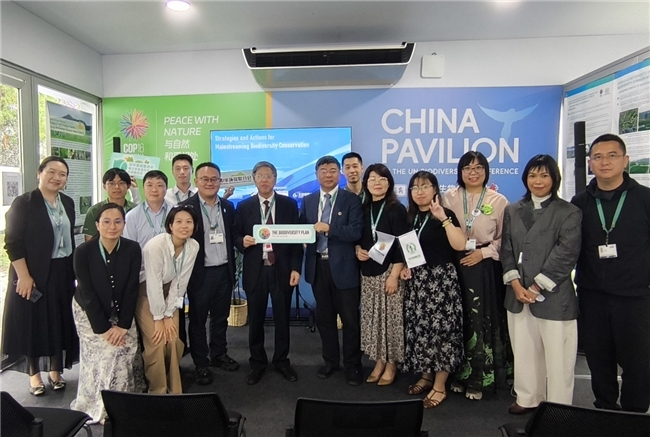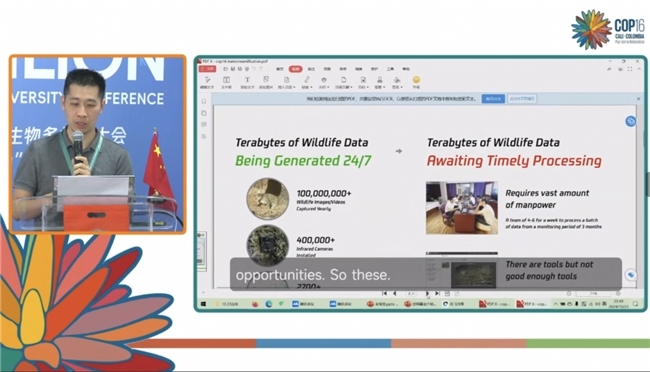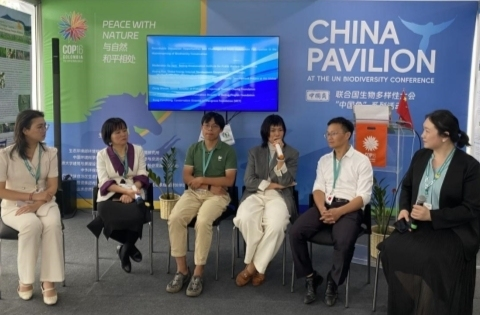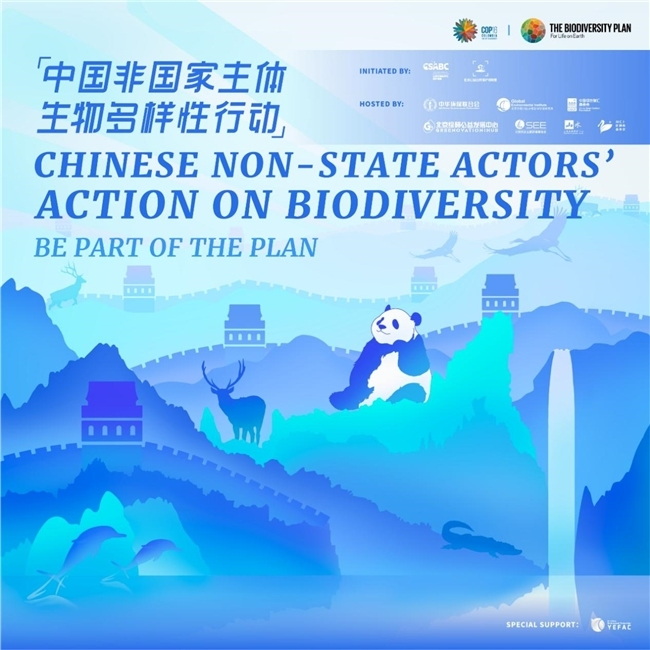

Date issued:2024-10-29
Spotlight on COP16 | "China Pavilion" IV: The Side Event on "Practice and experience in Mainstreaming Biodiversity " was successfully held.
On October 23rd at 9:00 AM Colombia time, at the China Pavilion of the 16th Conference of the Parties (COP16) to the United Nations Convention on Biological Diversity, a side event themed "Practice and experience in Mainstreaming Biodiversity "was successfully held. The event was organized by the All-China Environment Federation, supported by the Environmental Planning Institute of the Ministry of Ecology and Environment, and Tencent Group, and co-organized by the China Green Carbon Foundation, Beijing Green Research Public Welfare Development Center, and Shenzhen Mangrove Wetland Conservation Foundation. Representatives from governments, international organizations, and enterprises attended the meeting to engage in in-depth discussions on the topic of mainstreaming biodiversity conservation, contributing Chinese wisdom to COP16.

Figure 1: Group photo of the side event speakers.
Academician of the Chinese Academy of Engineering and Honorary President of the Chinese Academy of Environmental Planning, Wang Jinnan, shared the policy progress of China's mainstreaming of biodiversity conservation. He stated that since the Kunming-Montreal Framework was reached at COP15, China has revised the "Strategy and Action Plan for Biodiversity Conservation," deploying priority areas including the mainstreaming of biodiversity, sustainable use and benefit-sharing of biodiversity, and the modernization of biodiversity governance capabilities. This has facilitated the basic establishment of relevant policies, regulations, systems, standards, and monitoring systems for biodiversity conservation and provided an interpretation of the key content of biodiversity mainstreaming. Subsequently, Vice Chairman of COP15 and First-Level Inspector of the Ministry of Ecology and Environment, Liu Ning, shared insights around the Kunming Fund and biodiversity mainstreaming, which are of concern to all parties. He indicated that the Kunming Biodiversity Fund is the first international multilateral fund in the field of biodiversity initiated by China, focusing on financing developing country parties to develop biodiversity strategies and action plans, develop national resource mobilization strategies, develop regulations and standards conducive to biodiversity conservation, and promote the assessment of biodiversity strategies and actions, thereby advancing the process of biodiversity mainstreaming. The Kunming Fund adheres to multilateralism and international operation as basic principles, cooperates closely with the Secretariat of the Convention on Biological Diversity and other United Nations agencies, and encourages developed countries to contribute to the Kunming Fund to jointly support the implementation of the goals of the "Kunming-Montreal Framework."

Figure 2 Online live broadcast of the side event (pictured is a Tencent representative sharing a technical case).
During the keynote speech segment, Zhou Yilin, the Product Manager for Technological Public Welfare at Tencent's Sustainable Social Value Division (SSV), first shared Tencent's latest practices in biodiversity conservation, including species identification AI, wildlife infrared camera shooting mini-programs, and universal software development toolkits. He stated that while Tencent is exploring the introduction of cutting-edge technology into the field of biodiversity conservation, it is also continuously strengthening public participation and guidance during project implementation. They are developing interesting, easy-to-use, and efficient interactive interfaces for species data software to encourage more public and volunteers to understand and participate in species discovery and identification, aiding in the mainstreaming of biodiversity conservation. Subsequently, Xu Xin, Director of External Affairs for The Nature Conservancy (TNC) China Program, analyzed the complex social challenges currently faced by biodiversity conservation from the perspective of an international organization. He suggested that the mainstreaming of biodiversity conservation should focus more on the integration of nature and economy, as well as multi-party participation, and shared the value and standards of nature-based solutions (NbS) with the attendees. Li Zongyuan, Director of Strategic Projects at the Youth Environmental Friendly Action Committee of the China Environmental Protection Federation, shared on the theme of "Exploring a Chinese-style mechanism for public participation in biodiversity," highlighting three key projects in biodiversity conservation: "Species Encounters: Biodiversity Mainstreaming Public Action," "Guarding the Flying Dreams - Chinese Youth's Public Welfare Action for Bird Care," and "YEAH Energy Field - Environmentally Friendly Youth Community." Hou Yuanqing, Deputy Secretary-General of the China Green Carbon Foundation, Jiang Xueyuan, a researcher at the Beijing Green Research and Development Center, and Chen Can, Deputy Secretary-General of the Chongqing Land-Sea International Communication Public Welfare Foundation, then shared their perspectives and practices from different angles, including the synergy between biodiversity conservation and climate change response, national strategies for biodiversity conservation, and in-situ species protection. Representatives from China Three Gorges Corporation, China Harbour Engineering Company Limited, Zhenggu (Beijing) Agricultural Development Co., Ltd., State Grid Jiangsu Electric Power Company Yangzhou Power Supply Branch, and Wuxi Power Supply Branch, brought first-line action cases of sustainable organic agriculture and power development and species protection to the guests in the corporate case section, showcasing the companies' experiences and explorations in biodiversity conservation.

Figure 3 Roundtable Discussion Session
Roundtable Discussion Session: Representatives from the Global Energy Interconnection Development and Cooperation Organization, the Sustainia Global Environment Institute, Tencent's Sustainable Social Value Division, the Beijing Pinglan Public Welfare Foundation, and the Shenzhen Mangrove Foundation discussed the opportunities and challenges of mainstreaming biodiversity conservation from the perspective of multiple stakeholders, leveraging their respective institutional backgrounds and areas of expertise. Deng Wenjie, the Ecological and Environmental Officer of Tencent's Sustainable Social Value Division, believes that exploring more OECMs (Other Effective Area-based Conservation Measures) within cities, connecting the public with their surroundings, and promoting the construction of volunteer systems in the field of ecological and environmental protection will be key directions for influencing public awareness, supporting urban biodiversity construction, and advancing the mainstreaming process in the future. Peng Kui, the Director of the Ecological Protection and Community Development Project at the Global Environment Institute, emphasized the importance of promoting community-based mainstreaming work, stating that the public should understand the value of grassroots community wisdom in protecting biodiversity and that more policymakers should be made aware that biodiversity conservation can be achieved through local protection. Huang Kun, the Head of the Membership Office at the Global Energy Interconnection Development and Cooperation Organization, believes that integrating ecological protection mechanisms and systematic strategies such as AI large model analysis in the development of renewable energy can not only achieve synergy between energy transition and biodiversity protection but also help incorporate biodiversity conservation into the mainstream of socio-economic development. The roundtable guests also engaged in in-depth discussions on hot topics such as public participation and strategy dissemination, sustainable livelihoods, and species protection.

Figure 4 Main Background of the Joint Booth

Figure 5 Federation Representatives Interacting with On-Site Guests
During the conference, the All-China Environment Federation (ACEF) also collaborated with seven civil society partner organizations from the Citizen Biodiversity Alliance to launch a two-week "China Non-State Actor Biodiversity Action" themed exhibition in the Blue Zone of the conference. Several display projects, including the "Species Encounters" Citizen Biodiversity Participation Program, Citizen Science - Wild Friends Plan, and the encounter with the mysterious big cat on the snowy summit, as well as the potential protected areas of OECMs, attracted the attention and praise of guests from various countries. Among them, the "Action Initiative of Environmental Civil Society Organizations to Support the Mainstreaming of Biodiversity" released by the ACEF during the CBD COP15, actively echoed the theme of COP16 "Living in Harmony with Nature" and the overall goal of incorporating biodiversity into the economic policies of countries. It also clearly proposed action strategies for environmental civil society organizations to participate in the mainstreaming of biodiversity protection, which once again received support from civil society organizations from various countries during the exhibition.
 Comments
Comments




 Home
Home

 京公网安备 11010702002483
京公网安备 11010702002483